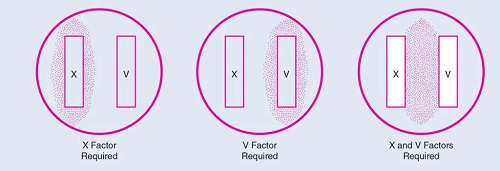X factor, V factor test - Introduction, Characteristics, Procedure, Result, Interpretation
Introduction to X factor, V factor test
X factor (hemin) and V factor (nicotinamide-adenine-dinucleotide, NAD; nicotinamide adenine dinucleotide phosphate, NADP) tests are done for the identification and/or differentiation of Haemophilus spp., especially the important human pathogen Haemophilus influenzae.
The X factor is used to produce essential respiratory enzymes such as cytochromes, catalases, and peroxidase while the V factor is used as an electron carrier in its oxidation-reduction system.
However, not all Haemophilus spp mark both X factor and V factor as essential and can grow in presence of just one factor. Also, some Haemophilus produce lysin which lyses blood to obtain NAD by themselves.
.png)
Fig: X and V factor test on Haemophilus influenzae (Source: ResearchGate)
Characteristics of X factor, V factor test
Some species of Haemophilus require both X factor and V factor or one of the two for growth. They fail to grow on supplemented blood agar, which contains X factor but lacks V factor, or other non-selective general media such as Trypticase Soy Agar (TSA), and Nutrient Agar (NA) which lacks both X and V factor.
Haemophilus spp. easily grows on chocolate agar (CA) because, in CA, the blood cells are already lyzed by heat, releasing NAD into the medium.
Another test similar to the X factor and V factor test with an identical principle is the Satellitism test.
Procedure to X factor, V factor test
The procedure for the X factor, and V factor tests are as follows:
Make a suspension of the test organism and match it to 1 McFarland turbidity standard. (Careful measures should be taken not to pick any media particles from the previous culture)
Using a sterile swab, lawn culture the test microorganism onto the TSA plate
Place each disc at least 4 to 5 cm apart, which has been impregnated with X, V, and XV factors, onto the inoculated plate
Inbuate at 35-37°C in a CO2 incubator for 18-24 hours.
* Instead of discs, strips of filter paper impregnated with the X factor, V factor, or both can also be used.

Fig: X and V factor test (Source: MicrobeOnline)
Result, Interpretation of X factor, V factor test
The result of X factor, and V factor tests can be interpreted as follows:
Negative
The growth of the test organism remains unaltered by the presence/absence of X, V, or XV discs. Also, the suspected microorganism may be able to grow well in the entire NA and TSA media.
Positive
Depending on the species of Haemophilus, colony growth can be observed near the disc containing the X factor, V factor, or XV factor while in the rest of the media, no growth is observed.
The requirements of Hemin, NAD in Haemophilus are as follows:
X factor (hemin) | V factor (NAD) | |
|---|---|---|
H. influenzae | + | + |
H. influenzae biotype aegyptius | + | + |
H. haemolyticus | + | + |
H. aphrophilus | – | – |
H. ducreyi | + | – |
H. parainfluenzae | – | + |
H. segnis | – | + |
H. parahaemolyticus | – | + |
H. paraphrophilus | – | + |
* (+) = required for growth
* (-) = not required for growth
Although Haemophilus influenzae and Haemophilus haemolyticus both show their dependence on X and V factors, they can be differentiated as Haemophilus haemolyticus shows β hemolysis on blood agar while Haemophilus influenzae are unable to hemolyze the blood cells.